

ALCATRAZ Proclamation - FoundSF. Primary Source Alcatraz Proclamation Photo: Ilka Hartmann The proclamation of the Indians of All Tribes who occupied Alcatraz from November 1969 to June 1971: To the Great White Father and All His People:
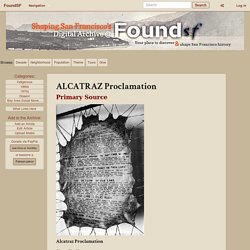
Native Knowledge 360° - Interactive Teaching Resources. “Indian New Deal” – Pieces of History. Today’s post from Eric Rhodes, intern in the National Archives History Office, highlights the National Archives’ Native American holdings in celebration of Native American Heritage Month.
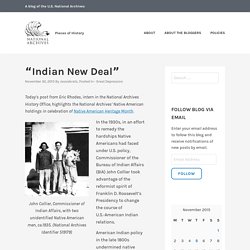
In the 1930s, in an effort to remedy the hardships Native Americans had faced under U.S. policy, Commissioner of the Bureau of Indian Affairs (BIA) John Collier took advantage of the reformist spirit of Franklin D. Roosevelt’s Presidency to change the course of U.S. -American Indian relations. Smithsonian Source. Timeline: Native American voting rights.
By Courtney Columbus and Erin Vogel-Fox During the past 180 years-plus, Native Americans have gone from being forced out of their homes to becoming accepted as citizens and granted the right to vote.
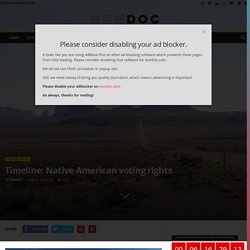
Even after all the persecution and progress, the struggle continues for Native American voting rights. History reveals itself to be repeating somewhat, as a 2013 Supreme Court decision removed protections against discriminatory practices in states with a track record of such prejudices. Timeline. The Supreme Court's changing stance on tribal sovereignty.
General Practice, Solo & Small Firm Division Philip J.
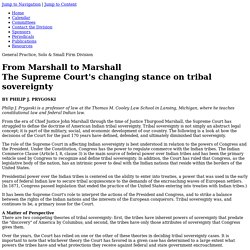
Prygoski is a professor of law at the Thomas M. Cooley Law School in Lansing, Michigan, where he teaches constitutional law and federal Indian law. From the era of Chief Justice John Marshall through the time of Justice Thurgood Marshall, the Supreme Court has struggled to define the doctrine of American Indian tribal sovereignty. 7. Native Americans and the Federal Government. Mexico’s Zapatista rebels, 24 years on and defiant in mountain strongholds. Diners in the Tierradentro cafe in the southern Mexican town of San Cristóbal de las Casas can choose between a variety of omelettes.

The “Liberty” has the most ingredients, the “Democracy” looks the best, but the “Justice” costs the most – possibly because it comes with cheese. The restaurant is one of many celebrating, or cashing in on, the Zapatistas, the indigenous peasant rights movement from dirt-poor Chiapas state, which took up arms and occupied San Cristóbal on 1 January 1994, the day Mexico signed up to Nafta, the North American free trade agreement. The rag-tag rebel Zapatista national liberation army (EZLN) – one-third women, some in bare feet, others with wooden guns – freed prisoners, burned military posts and seized ranches in protest at centuries of what they saw as oppression by large landowners and the government.
They became instant heroes of the left, and an inspiration to indigenous groups and political romantics around the world. “They are autonomous,” he adds. Battle for the mother land: indigenous people of Colombia fighting for their lands. A green-and-red flag flies over a cluster of bamboo and tarpaulin tents on the frontline of an increasingly deadly struggle for land and the environment in Colombia’s Cauca Valley. It is the banner for what indigenous activists are calling the “liberation of Mother Earth”, a movement to reclaim ancestral land from sugar plantations, farms and tourist resorts that has gained momentum in the vacuum left by last year’s peace accord between the government and the paramilitaries who once dominated the region – ending, in turn, the world’s longest-running civil war. The ragtag outpost in Corinto has been hacked out of a sugar plantation, destroyed by riot police, then reoccupied by the activists, who want to stop supplying coca (the main ingredient for cocaine) to drug traffickers in the mountains by cultivating vegetables on the plains instead.
The Nasa see this in historical, spiritual terms. Canada celebrates 150 but indigenous groups say history is being 'skated over' Two hundred paddlers will weave through the waters, their canoes carving a thin line in English Bay against the backdrop of Vancouver’s dramatic skyline.
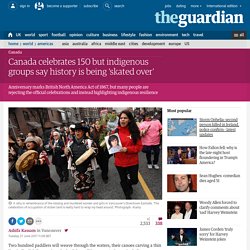
When they pull in to Vanier Park – one of the many destinations on their 10-day journey – local chiefs from the Musqueam, Squamish and Tsleil-Waututh First Nations will greet them and offer permission to step ashore on to their traditional territories. The protocol, which has played out on these lands for thousands of years, will be one of the signature events taking place next month as Vancouver marks the 150th anniversary of the signing of Canada’s confederation. The milestone is being commemorated across the country this year. But as maple leaf-adorned paraphernalia flies off store shelves and the capital city of Ottawa prepares for thousands of tourists to attend Canada Day celebrations on 1 July, some Canadians have been questioning what, exactly, is being celebrated.
Hispanics in America The History Channel 20th Century Mike Wallace. A commune in Chiapas? Mexico and the Zapatista rebellion, 1994-2000. Since the occupation of January 1994, many have projected their hopes onto this 'exotic' struggle against 'neo-liberalism'.

We examine the nature of the Zapatista uprising by moving beyond the bluster of the EZLN communiqués, on which so many base their analysis. Not proletarian, yet not entirely peasant, the Zapatistas' political ideas are riven with contradictions. We reject the academics' argument of Zapatismo's centrality as the new revolutionary subject, just as we reject the assertions of the 'ultra-left' that because the Zapatistas do not have a communist programme they are simply complicit with capital. Indigenous peoples in Latin America - a general overview. Udskriv There are approximately 40,000,000 people in Latin America and the Caribbean that belong to the almost 600 indigenous peoples of the continent, many of whom are in Mexico, Peru, Guatemala, Bolivia and Ecuador.

According to World Bank figures, 12.76% of the entire American population and approximately 40% of the rural population is indigenous. Bolivia's Rising Indigenous Bourgeoisie. Evo Morales speaks in favor of Indigenous development at the UN. Video: Evo Morales: Indigenous Rights. First of all, we’d like to salute, thank and recognize the countries of the world that approved and voted for this Declaration of the Rights of Indigenous Peoples, just as fifty, sixty years ago, the United Nations for the first time recognized the Universal Declaration of Human Rights.
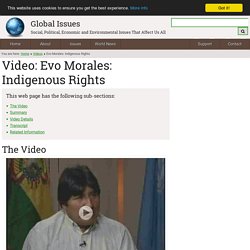
And it’s only now, over 500 years later, that indigenous people’s rights are being recognized. Happily, there were only a few countries that didn’t support this declaration.And so, I want to say to the indigenous peoples, but also to the other peoples who live in the cities, that this is a very important thing that the struggle for indigenous people’s rights has not been in vain. And it was very important to get organized to mobilize. EVO MORALES the film. Talk to Al Jazeera - Evo Morales: A Bolivian idol. Native American Artifacts. The Archaeological Resources Protection Act and The Native American Graves Protection and Repatriation Act by Judith Benderson Attorney, Office of Legal and Victim Programs, Executive Office for U.S.
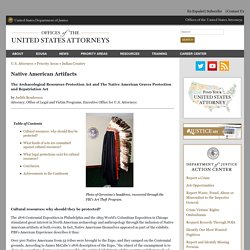
Attorneys. The Naked Truth: Mark Ruffalo Speaks on Standing Rock & #NoDAPL. Dakota Access pipeline: the who, what and why of the Standing Rock protests. The Native American protests against the Dakota Access pipeline have become an international rallying cry for indigenous rights and climate change activism, drawing thousands to the rural area of Cannon Ball, North Dakota.
As the controversial oil pipeline approaches the river that the Standing Rock Sioux tribe fears it will contaminate – and as a militarized police force continues to engage in tense standoffs with demonstrators – here is what we know so far. What is the Dakota Access pipeline? Standing Rock Sioux: 'we can't back down now' on Dakota pipeline fight. The Standing Rock Sioux tribe and its supporters are vowing to resist Donald Trump’s executive order to allow construction of the Dakota Access pipeline with legal action, civil disobedience and a return to the “water protector” encampments. “President Trump is legally required to honor our treaty rights and provide a fair and reasonable pipeline process,” said Standing Rock Sioux tribal chairman Dave Archambault, who called Trump’s action “politically motivated”. “Creating a second Flint does not make America great again,” he added. The executive order represents a major – if not wholly unexpected – reversal of fate for the $3.8bn project, which was slated to cross the Missouri River just upstream of the Standing Rock Sioux reservation.
The tribe feared the pipeline would contaminate their drinking water and destroy sacred sites. The denial of the permit – and initiation of an environmental impact statement – were expected to delay the pipeline’s completion by years. Timeline Records - Native Voices. Richard Nixon's Native American Federal Policy. By Dina Gilio-Whitaker Updated September 01, 2016. Modern American politics among various demographics can be traced along predictable lines when it comes to a two-party system, especially those of ethnic minorities.
Original americans 500 Nations. Occupy Wounded Knee: A 71-Day Siege and a Forgotten Civil Rights Movement - The Atlantic. The death of Russell Means serves as a reminder of the vision of the American Indian Movement. Russell Means, right, beats the drum at a meeting of the Wounded Knee occupation on March 10, 1973. A photojournalist who managed to get inside the cordon made a series of images of the stand-off and negotiations. American Indian Movement Documents from MSU. A Photographer Remembers Wounded Knee, 40 Years Later : The Picture Show. Lakota, Dakota, Nakota - The Great Sioux Nation. Bury My Heart at Wounded Knee - Wikipedia. We Hold the Rock. "You Are On Indian Land": The 1969 Indian Occupation of Alcatraz.
We Are Still Here Nanticoke and Lenape History Booklet pre release v2. NCHGC: History: Native Cultures: Navajo. American Indians in the 20th Century. "We Are Still Here": American Indians in the Twentieth Century - Peter Iverson. Native Americans and the Federal Government. Alcatraz source. Contemporary Native Photographers and the Edward Curtis Legacy - Portland Art Museum.
Edward Sheriff Curtis. American Experience. American Indian Activist Russell Means Powerful Speech, 1989. Russell Means. The Trail of Tears. (3) We Shall Remain - Trail of Tears.